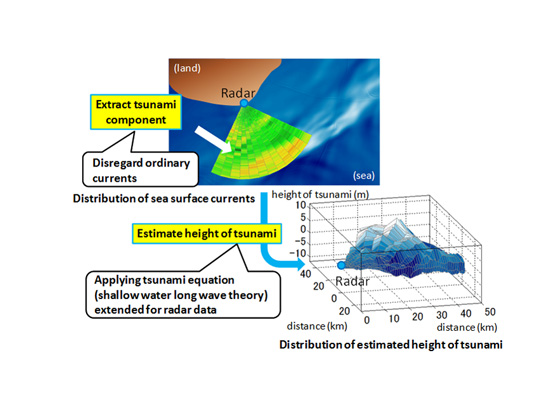News Release Archives
Note that the releases are accurate at the time of publication but may be subject to change without notice.
FOR IMMEDIATE RELEASE No. 2909
Mitsubishi Electric's New Technologies Enhance Tsunami Radar Monitoring
Earlier detection allows more time for evacuation of coastal communities
TOKYO, February 17, 2015 - Mitsubishi Electric Corporation (TOKYO: 6503) announced today that it has developed new technologies to improve the visibility and height estimation of tsunamis by using unprecedented procedures for extracting tsunami information from conventional radar observations of sea surfaces. The technologies, which Mitsubishi Electric will make available during the fiscal year starting in April, are expected to help observers detect tsunamis earlier and give evacuators more time to implement emergency countermeasures.

According to the Japan Society of Civil Engineers, oceanographic radars can observe currents on ocean surfaces for up 50 kilometers offshore. The speed of tsunamis can reach 195km/h at 300 meters average sea depth, so a tsunami 50km offshore can reach the coast in 15 minutes. The Urban Renaissance Agency has determined at least a 10-minute early warning is required to successfully evacuate many communities threatened by an approaching tsunami.

According to the Japan Society of Civil Engineers, oceanographic radars can observe currents on ocean surfaces for up 50 kilometers offshore. The speed of tsunamis can reach 195km/h at 300 meters average sea depth, so a tsunami 50km offshore can reach the coast in 15 minutes. The Urban Renaissance Agency has determined at least a 10-minute early warning is required to successfully evacuate many communities threatened by an approaching tsunami.

One of Mitsubishi Electric's new technologies improves tsunami visibility by predicting and removing prevailing and tidal currents, thereby helping to reduce the time required to detect tsunamis using the radar data. Another new technology estimates tsunami height based on directional information observed by a single radar, which until now had been a technical difficulty. The procedure expands on a tsunami model that is based on shallow-water long-wave theory, which expresses the relationship between tsunami height and direction maps. As a result, tsunami height can be estimated in real time.

High-frequency (short) radio waves used for oceanographic radar propagate along sea surfaces, enabling information to be collected in areas extending more than 20 km offshore. Optical sensors and conventional radar using microwaves are limited to line of sight because of the earth's curvature.

Oceanographic radars that Mitsubishi Electric began selling since 1999 are designed to observe ordinary ocean currents, but they do not detect tsunamis. Following the East Japan Great Earthquake on March 11, 2011, which triggered a massive, deadly tsunami, there were several reports that tsunamis had been successfully detected by oceanographic radars. As a result, Mitsubishi Electric began working on unprecedented tsunami-monitoring technologies for use with conventional oceanographic radars. The company greatly hopes that its new technologies help to minimize further loss of life in coastal areas due to tsunami.

High-frequency (short) radio waves used for oceanographic radar propagate along sea surfaces, enabling information to be collected in areas extending more than 20 km offshore. Optical sensors and conventional radar using microwaves are limited to line of sight because of the earth's curvature.
Oceanographic radars that Mitsubishi Electric began selling since 1999 are designed to observe ordinary ocean currents, but they do not detect tsunamis. Following the East Japan Great Earthquake on March 11, 2011, which triggered a massive, deadly tsunami, there were several reports that tsunamis had been successfully detected by oceanographic radars. As a result, Mitsubishi Electric began working on unprecedented tsunami-monitoring technologies for use with conventional oceanographic radars. The company greatly hopes that its new technologies help to minimize further loss of life in coastal areas due to tsunami.
Inquiry
Customer Inquiries
Mitsubishi Electric Corporation